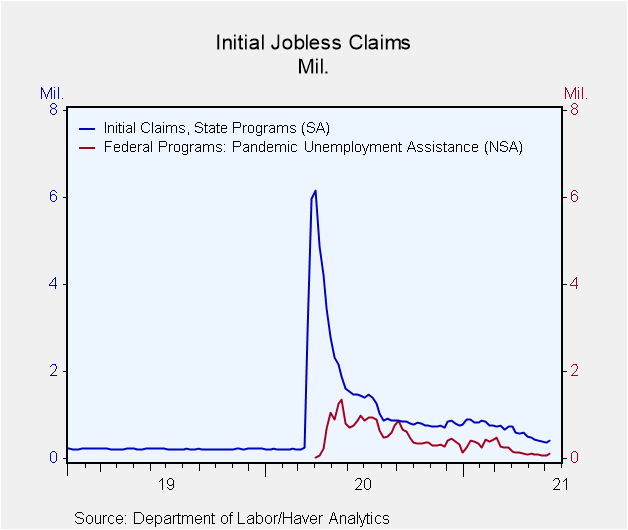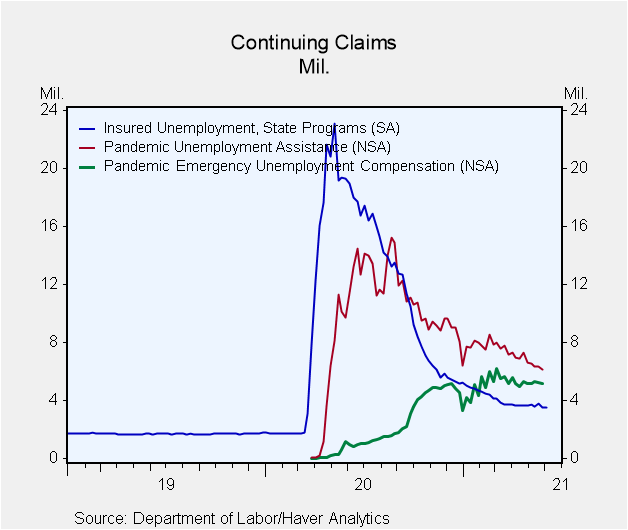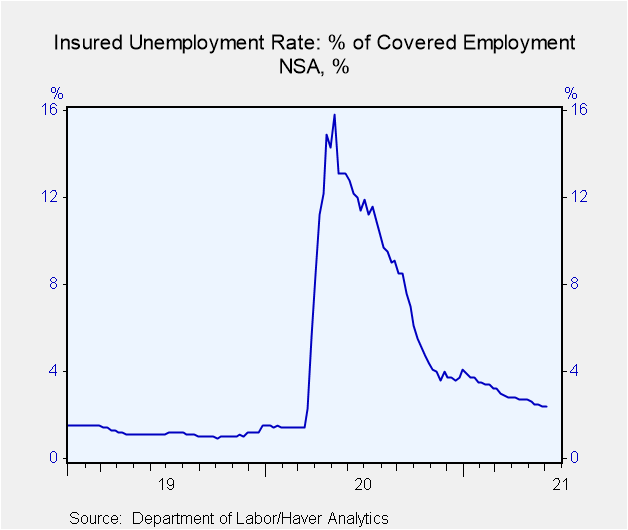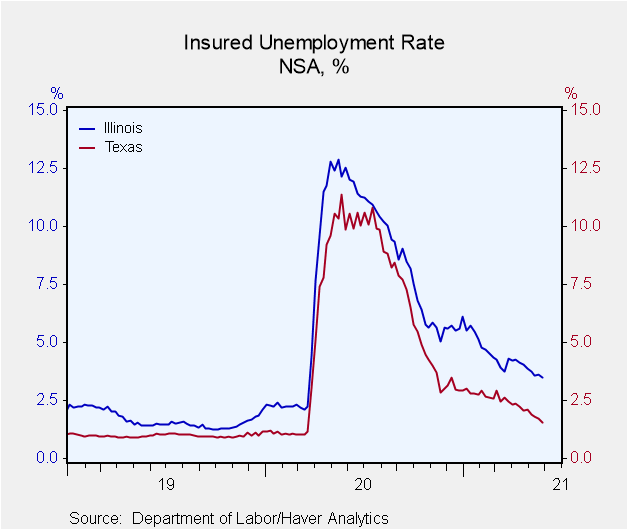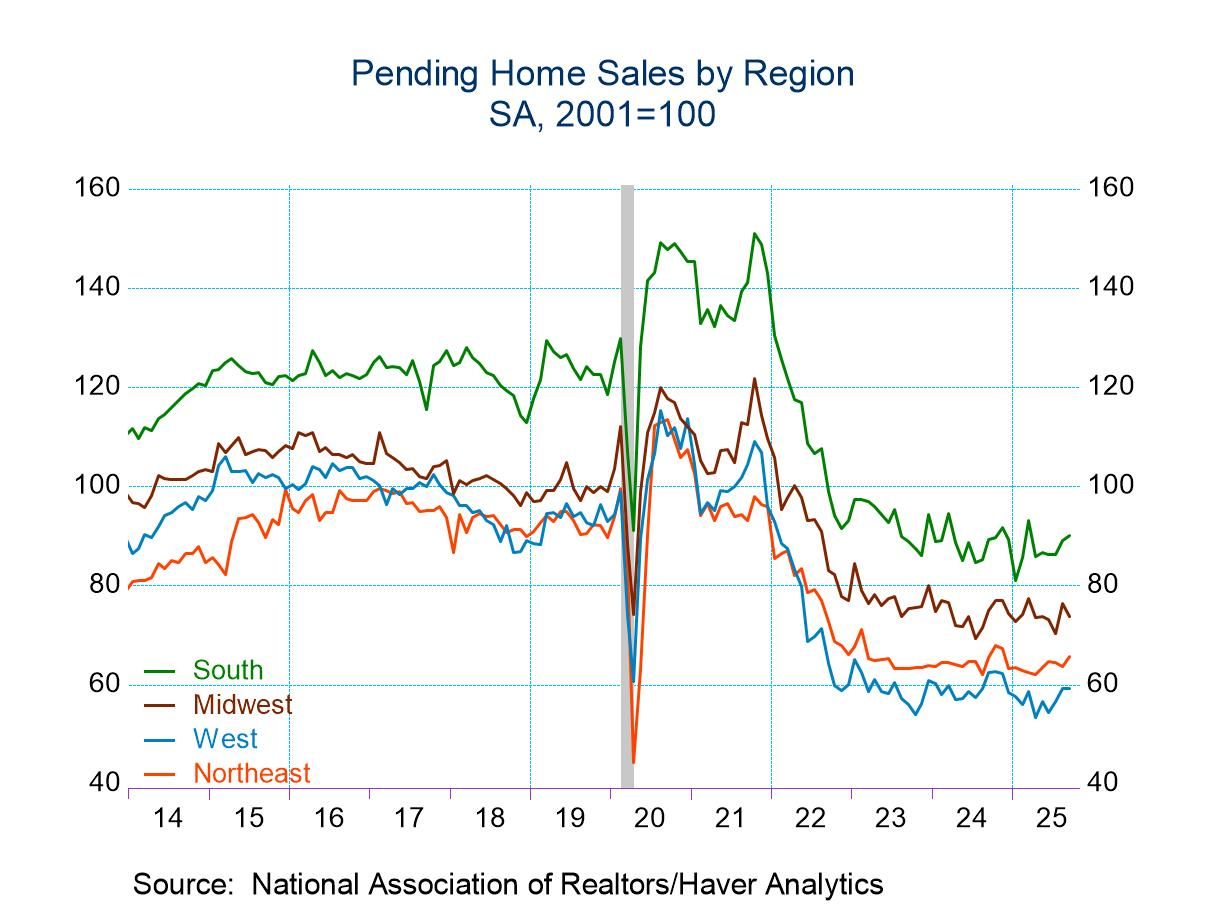 Global| Jun 17 2021
Global| Jun 17 2021U.S. Initial Claims for Unemployment Insurance Rise Unexpectedly
by:Tom Moeller
|in:Economy in Brief
Summary
• Increase in initial state claims is first since late-April. • Continuing state claims are roughly steady at pandemic low. • PUA claims continue to decline. Initial claims for unemployment insurance increased 37,000 during the week [...]
• Increase in initial state claims is first since late-April.
• Continuing state claims are roughly steady at pandemic low.
• PUA claims continue to decline.
Initial claims for unemployment insurance increased 37,000 during the week ended June 12 to 412,000 from 375,000 in the prior week, revised from 376,000. The Action Economics Forecast Survey panel expected new claims to decline to 365,000. The 4-week moving average fell to 395,000 last week, a pandemic low, from 403,000 in the previous week.
Initial claims for the federal Pandemic Unemployment Assistance (PUA) program increased to 118,025 in the week ended June 12 from 71,303 in the prior week, revised from 73,249. The PUA program provides benefits to individuals who are not eligible for regular state unemployment insurance benefits, such as the self-employed. Given the brief history of this program, these and other COVID-related series are not seasonally adjusted.
Continuing claims for regular state unemployment insurance were little changed at 3.518 million in the week ended June 5, nearly a pandemic low. The insured rate of unemployment remained at 2.5%, again a pandemic low. This rate reached a high of 15.9% in the week of May 9, 2020.
Continuing claims for PUA fell to 6.121 million in the week ended May 29, down from 6.375 million the prior week. Continuing PEUC claims eased to 5.157 million. The Pandemic Emergency Unemployment Compensation (PEUC) program covers people who have exhausted their state unemployment insurance benefits.
The total number of all state, federal, and PUA and PEUC continuing claims was 14.829 million in the week ended May 29, down 559,873 from the previous week. This was the lowest reading since just after the pandemic-related programs began in early April 2020. It is not seasonally adjusted.
The state insured rates of unemployment in regular programs continued to vary widely. In the week ending May 29, the highest insured unemployment rates were in Nevada (4.60%), Rhode Island (4.52%), Alaska (3.89%), Pennsylvania (3.87%). New York (3.62%), California (3.62%) and Connecticut (3.57%). The lowest rates were in South Dakota (0.39%), Kansas (0.68%), Alabama (0.71%), Utah (0.72%) and Nebraska (0.78%). Insured unemployment rates in other large states included Illinois (3.47%), Texas (1.56%) and Florida (1.22%). These state rates are not seasonally adjusted.
Data on weekly unemployment claims going back to 1967 are contained in Haver's WEEKLY database, and they are summarized monthly in USECON. Data for individual states are in REGIONW. The expectations figure is from the Action Economics Forecast Survey, carried in the AS1REPNA database.
| Unemployment Insurance (SA, 000s) | 06/12/21 | 06/05/21 | 05/29/21 | Y/Y % | 2020 | 2019 | 2018 |
|---|---|---|---|---|---|---|---|
| Initial Claims | 412 | 375 | 388 | -72.0 | 1,352 | 218 | 220 |
| Initial Claims (NSA) | 402 | 365 | 429 | -72.4 | 1,353 | 218 | 221 |
| Initial Claims Pandemic Unemployment Assistance (NSA) | 118 | 71 | 73 | -84.6 | -- | -- | -- |
| Continuing Claims | -- | 3,518 | 3,517 | -81.4 | 10,380 | 1,699 | 1,754 |
| Continuing Claims (NSA) | -- | 3,288 | 3,333 | -82.4 | 10,370 | 1,704 | 1,763 |
| Continuing Claims Pandemic Unemployment Assistance (NSA) | -- | -- | 6,121 | -37.1 | -- | -- | -- |
| Insured Unemployment Rate (%) | -- | 2.5 | 2.5 |
12.2 |
7.1 | 1.2 | 1.2 |
Tom Moeller
AuthorMore in Author Profile »Prior to joining Haver Analytics in 2000, Mr. Moeller worked as the Economist at Chancellor Capital Management from 1985 to 1999. There, he developed comprehensive economic forecasts and interpreted economic data for equity and fixed income portfolio managers. Also at Chancellor, Mr. Moeller worked as an equity analyst and was responsible for researching and rating companies in the economically sensitive automobile and housing industries for investment in Chancellor’s equity portfolio. Prior to joining Chancellor, Mr. Moeller was an Economist at Citibank from 1979 to 1984. He also analyzed pricing behavior in the metals industry for the Council on Wage and Price Stability in Washington, D.C. In 1999, Mr. Moeller received the award for most accurate forecast from the Forecasters' Club of New York. From 1990 to 1992 he was President of the New York Association for Business Economists. Mr. Moeller earned an M.B.A. in Finance from Fordham University, where he graduated in 1987. He holds a Bachelor of Arts in Economics from George Washington University.


